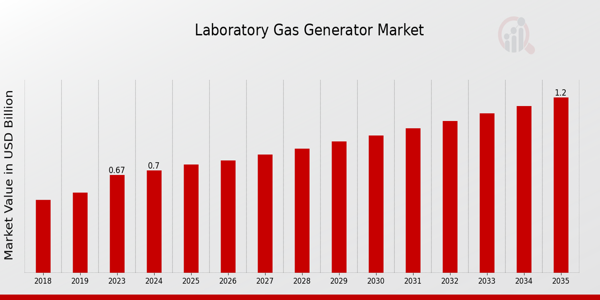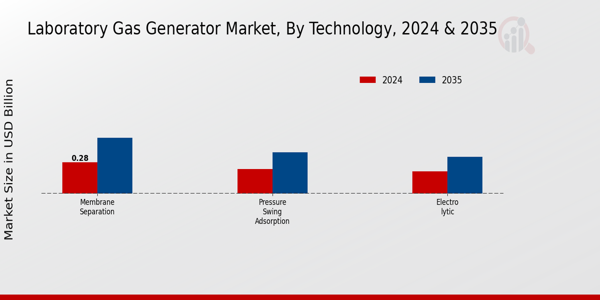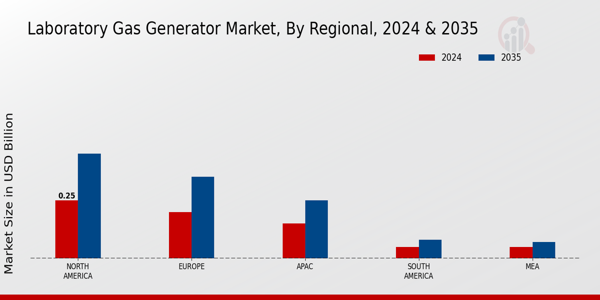Global Laboratory Gas Generator Market Overview
The Laboratory Gas Generator Market Size was estimated at 0.67 (USD Billion) in 2023. The Laboratory Gas Generator Industry is expected to grow from 0.7(USD Billion) in 2024 to 1.2 (USD Billion) by 2035. The Laboratory Gas Generator Market CAGR (growth rate) is expected to be around 5.0% during the forecast period (2025 - 2035).
Key Laboratory Gas Generator Market Trends Highlighted
The global laboratory gas generator market is witnessing significant growth, driven by the increasing need for reliable and safe gas supplies in laboratories. Advances in technology have led to the development of efficient and cost-effective gas generation systems, which enhance operational efficiency and reduce dependency on gas cylinder deliveries. Furthermore, the growing focus on sustainability and reducing carbon footprints is prompting laboratories to adopt gas generators that produce gases on-site, minimizing waste and transportation-related emissions. The trend towards automation in laboratories is also a crucial driver, leading to higher demand for integrated gas systems that seamlessly connect with other laboratory equipment.The marketing of high-purity gases is expanding because the Pharmaceuticals, biotechnology, and environmental testing industries are looking for ways to enhance their processes and gas generators can provide high-purity gases with great efficiency. There is an increase in activities involving R&D in the life sciences, which results in an increased demand. There is also the emerging trend of lean and green, which can allow companies to invest in new gas generation technologies that meet the new environmental goals. This trend enables businesses that offer tailored responses to different laboratory needs to exploit the gaps in the market.
Recent trends indicate a shift towards more advanced and compact gas generator designs that occupy less space and offer higher reliability. The adoption of digital technologies and IoT integration is also on the rise, allowing for real-time monitoring and remote management of gas delivery systems. These developments not only improve safety but also contribute to enhanced productivity in laboratory settings. The increasing recognition of the benefits of on-site gas generation solutions over traditional gas supply methods is likely to shape the future landscape of the global laboratory gas generator market in the years to come.

Source: Primary Research, Secondary Research, MRFR Database and Analyst Review
Laboratory Gas Generator Market Drivers
Growing Demand for Laboratory Automation
The Global Laboratory Gas Generator Market Industry is experiencing significant growth driven by the increasing demand for laboratory automation. As laboratories strive to improve efficiency, accuracy, and throughput in their operations, automated processes have become essential. Laboratory gas generators play a critical role in the automation of various analytical processes, providing a reliable and consistent supply of gases required for experiments and instrumentation.The ability to generate gases on-site eliminates the risks associated with gas cylinder handling, such as leaks and contamination, which is crucial for maintaining the integrity of sensitive experiments. With advancements in technology, modern laboratory gas generators are equipped with automated controls and monitoring systems, enhancing usability and reducing the need for manual intervention. This trend is particularly prominent in sectors such as pharmaceuticals, biotechnology, and academic research institutions, where the need for precise and reproducible results is vital.Furthermore, as laboratories expand their capabilities by incorporating advanced analytical techniques that require specific gas mixtures and purities, laboratory gas generators provide a versatile solution to meet these evolving needs. Overall, the drive towards automation in laboratories is a key factor propelling the growth of the Global Laboratory Gas Generator Market. The integration of gas generation technology within automated laboratory environments increases operational efficiency while reducing the total cost of ownership associated with traditional gas supply methods.
Rising Focus on Sustainability and Green Initiatives
The Global Laboratory Gas Generator Market Industry is also being propelled by a rising focus on sustainability and environmentally friendly practices within laboratory settings. Laboratories are increasingly aware of their environmental footprint and are actively seeking ways to reduce waste and optimize resource utilization. Laboratory gas generators align perfectly with this shift as they minimize dependency on traditional gas cylinder supplies, which often lead to substantial environmental waste due to manufacturing, transportation, and disposal issues.By generating gases on-site, laboratories can significantly reduce their carbon footprint and contribute to green initiatives, thus supporting global sustainability goals. Additionally, advancements in gas generator technology promote energy efficiency and lower emissions, further enhancing their appeal as a sustainable solution for laboratories. As more organizations adopt green practices, the demand for laboratory gas generators is expected to rise, driving growth within the Global Laboratory Gas Generator Market.
Expanding Applications Across Various Industries
The Global Laboratory Gas Generator Market Industry is witnessing growth as the applications of laboratory gas generators expand across diverse industries. Sectors such as pharmaceuticals, biotechnology, aerospace, and environmental testing increasingly rely on precise gas supply for analytical and quality control processes. As the range of applications continues to broaden, the demand for tailored gas generation solutions that meet specific industry requirements is on the rise.This trend opens new opportunities for manufacturers and suppliers of laboratory gas generators to innovate and provide customized solutions, thereby enhancing their market reach and driving overall market growth.
Laboratory Gas Generator Market Segment Insights
Laboratory Gas Generator Market Technology Insights
The Global Laboratory Gas Generator Market is witnessing substantial growth in the Technology segment, with market revenue projected to reach 0.7 USD Billion in 2024, reflecting its increasing importance in various laboratory applications. This segment consists of three primary technologies: Membrane Separation, Pressure Swing Adsorption, and Electrolytic, each contributing significantly to overall market dynamics. Among these, Membrane Separation is expected to hold a majority due to its projected growth from 0.28 USD Billion in 2024 to 0.5 USD Billion in 2035. This technology is favored for its efficient gas separation capabilities, making it essential in laboratories requiring high-purity gases. In contrast, Pressure Swing Adsorption is also noteworthy, with market values climbing from 0.22 USD Billion in 2024 to 0.37 USD Billion in 2035. Its application in generating pure gases for labs enhances operational efficiency, showcasing its vital role in the sector. Meanwhile, Electrolytic technology, though valued at 0.2 USD Billion in 2024 and expected to increase to 0.33 USD Billion by 2035, continues to attract attention due to its clean and safe production of gases, reflecting a growing trend towards sustainability in laboratory practices. The overall Global Laboratory Gas Generator Market statistics indicate a move towards more efficient and sustainable technologies, driven by the rising demand for high-purity gases across industries like pharmaceuticals, biotechnology, and research. The opportunities in the market are substantial, with advancements in technology enhancing performance and reducing operational costs. However, challenges such as high initial investment costs and the need for maintenance may dampen some growth prospects. Collectively, the segment stands as a crucial part of the Global Laboratory Gas Generator Market, contributing to both revenue generation and innovations in laboratory gas solutions.

Source: Primary Research, Secondary Research, MRFR Database and Analyst Review
Laboratory Gas Generator Market Gas Type Insights
The Global Laboratory Gas Generator Market is experiencing notable growth within the Gas Type segment, which encompasses gases such as Nitrogen, Hydrogen, Oxygen, and Carbon Dioxide. By 2024, the market was valued at approximately 0.7 billion USD and is set to expand significantly by 2035, reflecting the increasing demand for reliable gas generation solutions in laboratory settings. Nitrogen gas generators are essential for applications requiring inert environments, making them a critical component in laboratory operations. Hydrogen gas is gaining traction due to its role in fuel cells and analytical instruments, while Oxygen production serves vital functions in medical and industrial applications.Carbon Dioxide generators are also important for specific laboratory experiments and procedures, indicating the diverse utility of gases in research and development. The need for efficient, on-site gas production drives the market growth, supported by advancements in technology and a shift towards sustainable practices in various industries. However, challenges such as initial setup costs and maintenance may present hurdles that affect adoption rates. Overall, the Global Laboratory Gas Generator Market showcases a promising outlook as it adapts to the evolving needs of laboratories worldwide.
Laboratory Gas Generator Market End User Insights
The Global Laboratory Gas Generator Market revenue is anticipated to experience steady growth, particularly within the End User segment, which includes key industries such as Pharmaceuticals, Research Laboratories, Food Beverages, and Educational Institutions. In 2024, the market is expected to be valued at 0.7 billion USD, signaling a robust demand for laboratory gas generators across various applications. The pharmaceuticals industry plays a crucial role, with a significant reliance on high-purity gases for processes like drug formulation and testing, ensuring product safety and efficacy.Research laboratories also greatly contribute to market dynamics, as they require a consistent gas supply for experiments that demand accuracy and reliability. The food and beverages sector utilizes laboratory gas generators for quality control and packaging processes, emphasizing safety standards in food production. Educational institutions represent another vital segment, as they invest in laboratory setups that support hands-on learning and research in scientific disciplines. Overall, the Global Laboratory Gas Generator Market segmentation highlights the diverse applications and the growing necessity in different sectors, driven by the increasing focus on research and quality assurance.As the market evolves, it presents opportunities for innovation and efficiency improvements within industrial settings.
Laboratory Gas Generator Market Mode of Operation Insights
The Global Laboratory Gas Generator Market is witnessing substantial growth within its Mode of Operation segment, reflecting a market value of USD 0.7 billion in 2024. The focus on this segment highlights the increasing demand for efficient and reliable laboratory gas solutions. Among the aspects of operation, Continuous generation stands out as a significant contributor to market dynamics due to its ability to provide a steady flow of gases, which is crucial for various laboratory applications. This mode enhances productivity, especially in environments requiring a constant gas supply.Conversely, Batch generation also plays a vital role, offering flexibility for smaller scale operations where specific gas requirements are needed intermittently. The steady growth reflected in Global Laboratory Gas Generator Market statistics underscores the rising importance of these modes of operation, driven by advancements in technology and the need for cost-effective solutions. As laboratories strive for efficiency and precision in their processes, the adoption of these modes remains pivotal in shaping the industry's landscape. Ultimately, the segmentation within the Global Laboratory Gas Generator Market emphasizes the critical role that both Continuous and Batch operations play in meeting diverse laboratory needs.
Laboratory Gas Generator Market Regional Insights
The Global Laboratory Gas Generator Market demonstrates considerable diversity across its Regional segment, with North America leading in market valuation. In 2024, it holds a significant share at 0.25 USD Billion, projecting growth to 0.45 USD Billion by 2035, emphasizing its majority holding driven by extensive research and development activities. Europe follows closely, valued at 0.2 USD Billion in 2024, with an expected rise to 0.35 USD Billion, benefitting from strong regulatory standards in laboratory practices. The APAC region, valued at 0.15 USD Billion in 2024, is projected to grow to 0.25 USD Billion, reflecting increasing investments in scientific research and industrial applications.South America and MEA, though smaller markets, show growth potential, with valuations of 0.05 USD Billion each in 2024, expected to reach 0.08 USD Billion and 0.07 USD Billion, respectively, by 2035. The growth across these regions is influenced by advancements in laboratory technology, regulatory compliance, and rising demand for eco-friendly alternatives in gas generation, highlighting various opportunities within the Global Laboratory Gas Generator Market data framework. The market growth is further fueled by innovation trends aimed at enhancing operational efficiency and sustainability in gas generation.

Source: Primary Research, Secondary Research, MRFR Database and Analyst Review
Laboratory Gas Generator Market Key Players and Competitive Insights
The Global Laboratory Gas Generator Market is characterized by a diverse array of competitors, each offering innovative technologies and solutions that cater to the varying needs of laboratories and research facilities. This market has witnessed substantial growth due to the increasing demand for efficient and reliable gas generation systems, which are critical for various applications such as chromatography, spectrometry, and other analytical processes. The competitive landscape includes established manufacturers as well as emerging players, each striving to enhance their product offerings and market share through technological advancements and strategic partnerships. As demand escalates, companies are focusing on sustainability, cost-effectiveness, and customization to meet specific customer requirements, further intensifying competition within the sector.Luyuan has established a significant presence in the Global Laboratory Gas Generator Market, known for its commitment to quality and innovation. The company has positioned itself as a leader by consistently developing state-of-the-art gas generator systems that offer high purity and reliability. Luyuan's strengths lie in its robust research and development capabilities, enabling it to introduce cutting-edge solutions that meet the evolving needs of the laboratory environment. Furthermore, Luyuan emphasizes customer satisfaction through tailored solutions and excellent after-sales support, ensuring clients get optimal performance from their gas generators. This focus on quality, alongside a responsive approach to market demands, reinforces Luyuan's competitive edge and solidifies its position in the industry.Sartorius AG holds a prominent position in the Global Laboratory Gas Generator Market, leveraging its extensive expertise in laboratory and bioprocessing technologies. The company is recognized for its advanced gas generation systems that are designed with user-friendliness and efficiency in mind. Sartorius AG's strengths lie in its strong brand reputation, a comprehensive product portfolio, and an unwavering focus on innovation, enabling it to cater not only to laboratory needs but also to broader biopharmaceutical applications. By integrating digital solutions and automation into their gas generating technologies, Sartorius AG enhances operational efficiency for its customers. This commitment to performance and reliability has positioned Sartorius AG as a key player in the evolving landscape of laboratory gas generation, helping to drive progress and solutions in various research and analytical settings.
Key Companies in the Laboratory Gas Generator Market Include:
- Luyuan
- Sartorius AG
- Air Products and Chemicals
- Nexus Gas Systems
- Parker Hannifin
- Yamato Scientific
- Air Liquide
- GCE Group
- KiddeFenwal
- Matheson TriGas
- TechnipFMC
- Quincy Compressor
- Kaeser Compressors
- Messer Group
- Linde
Laboratory Gas Generator Market Industry Developments
In recent developments within the Global Laboratory Gas Generator Market, companies such as Air Products and Chemicals and Linde have been focusing on expanding their market presence through various innovative solutions aimed at improving gas delivery efficiency. Sartorius AG has introduced advancements in its systems that enhance the reliability of laboratory gas generation. The demand for eco-friendly and sustainable gas solutions has also prompted companies like Air Liquide and Messer Group to invest in greener technologies. In terms of mergers and acquisitions, Parker Hannifin has been in discussions to potentially acquire smaller entities specializing in gas generation technologies, aiming to broaden its product portfolio. Additionally, Matheson TriGas has reported on strategic partnerships to enhance distribution capabilities, reflecting the growing coordination between major players. The overall market valuation for these companies is steadily increasing, driven by a surge in demand from the healthcare, pharmaceuticals, and research sectors, indicating a positive trend that is impacting the competitive landscape significantly. Companies such as GCE Group and Nexus Gas Systems are also witnessing growth as they adapt to these market shifts effectively.
Laboratory Gas Generator Market Segmentation Insights
Laboratory Gas Generator Market Technology Outlook
- Membrane Separation
- Pressure Swing Adsorption
- Electrolytic
Laboratory Gas Generator Market Gas Type Outlook
- Nitrogen
- Hydrogen
- Oxygen
- Carbon Dioxide
Laboratory Gas Generator Market End User Outlook
- Pharmaceuticals
- Research Laboratories
- Food Beverages
- Educational Institutions
Laboratory Gas Generator Market Mode of Operation Outlook
Laboratory Gas Generator Market Regional Outlook
- North America
- Europe
- South America
- Asia Pacific
- Middle East and Africa
|
Report Attribute/Metric
|
Details
|
|
Market Size 2023
|
0.67 (USD Billion)
|
|
Market Size 2024
|
0.7 (USD Billion)
|
|
Market Size 2035
|
1.2 (USD Billion)
|
|
Compound Annual Growth Rate (CAGR)
|
5.0% (2025 - 2035)
|
|
Report Coverage
|
Revenue Forecast, Competitive Landscape, Growth Factors, and Trends
|
|
Base Year
|
2024
|
|
Market Forecast Period
|
2025 - 2035
|
|
Historical Data
|
2019 - 2024
|
|
Market Forecast Units
|
USD Billion
|
|
Key Companies Profiled
|
Luyuan, Sartorius AG, Air Products and Chemicals, Nexus Gas Systems, Parker Hannifin, Yamato Scientific, Air Liquide, GCE Group, KiddeFenwal, Matheson TriGas, TechnipFMC, Quincy Compressor, Kaeser Compressors, Messer Group, Linde
|
|
Segments Covered
|
Technology, Gas Type, End User, Mode of Operation, Regional
|
|
Key Market Opportunities
|
Rising demand for clean energy, Growth in healthcare and pharmaceuticals, Increasing adoption of automation, Expansion in research and development, Technological advancements in gas generation
|
|
Key Market Dynamics
|
Technological advancements, Increasing laboratory automation, Rising demand for pure gases, Growth in research and development, Environmental regulations and compliance
|
|
Countries Covered
|
North America, Europe, APAC, South America, MEA
|
Frequently Asked Questions (FAQ) :
The Global Laboratory Gas Generator Market is expected to be valued at 0.7 USD Billion in the year 2024.
By 2035, the Global Laboratory Gas Generator Market is anticipated to reach a valuation of 1.2 USD Billion.
The expected CAGR for the Global Laboratory Gas Generator Market from 2025 to 2035 is 5.0%.
In 2024, North America is projected to have the largest market value at 0.25 USD Billion.
In 2035, the market value for Europe is expected to reach 0.35 USD Billion.
The Membrane Separation technology segment is anticipated to dominate the market in 2024 with a value of 0.28 USD Billion.
The market size of the Pressure Swing Adsorption technology is expected to be 0.37 USD Billion in 2035.
Key players in the market include Luyuan, Sartorius AG, Air Products and Chemicals, and Parker Hannifin.
The projected market size for the Asia Pacific region in 2024 is 0.15 USD Billion.
There are significant growth opportunities in advancing technologies and increasing research and development activities in the market.

















